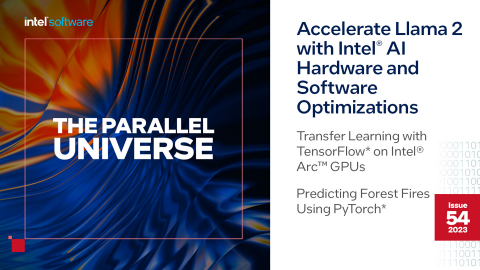LETTER FROM THE EDITOR
Announcing the Unified Acceleration Foundation!
I am excited to share that there is a big new way for all of us to help shape the future of open accelerated computing. On September 19, the Joint Development Foundation, part of the Linux Foundation family, announced the formation of the Unified Acceleration Foundation (UXL Foundation). This brings together many companies to enable true multivendor, multiarchitecture, software support for accelerated computing. The ULX Foundation is taking over the oneAPI specification and bringing together multiple organizations around the world to help shape an open future of accelerated computing. In upcoming issues, I hope to see submissions from foundation members as they expand the possibilities of accelerated computing.
In case you missed it, Intel [Joined] the PyTorch Foundation as a Premier Member last summer, so we have two articles in this issue featuring PyTorch*. First, our feature article, Accelerate Llama 2 with Intel® AI Hardware and Software Optimizations, illustrates the democratization of large language models. Second, Predicting Forest Fires Using PyTorch shows how to use transfer learning to efficiently build accurate image classifiers.
We also have articles on transfer learning and gradient boosting: Transfer Learning with TensorFlow* on Intel® Arc™ GPUs and Faster XGBoost*, LightGBM, and CatBoost Inference on the CPU.
Next, we have two articles on enterprise AI. In Boosting Business with AI, our collaborators at Red Hat show us how to use Red Hat OpenShift* Data Science and open-source AI technologies on Intel® architecture. This is a follow-up to their previous article, Supply Chain Optimization at Enterprise Scale (The Parallel Universe, Issue 52). Build Secure Kubeflow* Pipelines on Microsoft Azure* shows how to leverage the Intel® Software Guard Extensions to deploy secure, accelerated machine learning pipelines in the cloud.
Finally, we close this issue with part two of our look at heterogeneous parallelism with Fortran and OpenMP*. The Case for OpenMP Target Offloading expands on our simple edge detection example in Using Fortran DO CONCURRENT for Accelerator Offload (The Parallel Universe, Issue 53), using the more realistic Sobel edge detection algorithm.
As always, don’t forget to check out Tech.Decoded for more information on Intel solutions for AI and data science, code modernization, visual computing, data center and cloud computing, systems and IoT development, and heterogeneous parallel programming with oneAPI.
Henry A. Gabb
October 2023
Henry A. Gabb, Senior Principal Engineer at Intel Corporation, is a longtime high-performance and parallel computing practitioner who has published numerous articles on parallel programming. He was editor/coauthor of “Developing Multithreaded Applications: A Platform Consistent Approach” and program manager of the Intel/Microsoft Universal Parallel Computing Research Centers.
